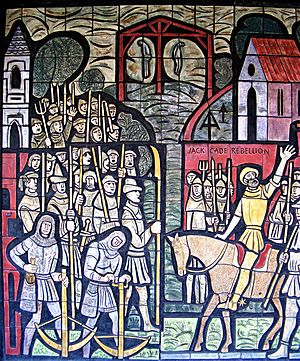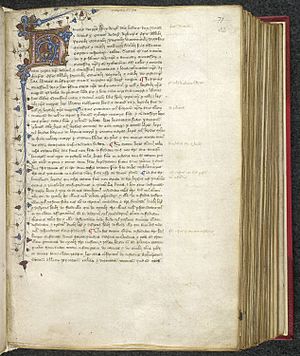John and William Merfold facts for kids
John and William Merfold were brothers from Sussex, England, in the mid-1400s. They were ordinary people, known as yeomen, who worked the land. In 1451, they were accused of encouraging people to harm the nobility and the clergy. They also wanted to remove King Henry VI from power.
The brothers believed that common people should rule the country. Their ideas led to small uprisings across Sussex. These events happened shortly after a big rebellion in Kent in 1450, led by Jack Cade. The Merfolds' actions show the deep disagreements between different social groups in England during the 15th century.
Contents
Why People Were Unhappy in 15th-Century England
For about 150 years after the Black Death in 1348–1349, England's population and economy faced tough times. The worst period was between 1440 and 1480, known as the Great Slump. This affected all of Europe. It was hard for both lords and peasants. England's economy only started to get better in the 1470s.
Many things caused this difficult period. There were very cold winters in the 1430s, followed by three bad harvests. There wasn't enough money or credit across Europe, especially in the 1460s. This was partly because England imported many luxury goods and silver mines produced less.
As the economy shrank, England's exports, like wool, dropped by half in just 20 years. Many wool workers lost their jobs, which hurt the whole economy. Things got worse when the English government's actions led to the Hanseatic League stopping trade with England. England also lost its markets in Flanders and France due to conflicts and losing land during the Hundred Years War.

King Henry VI and his government were partly responsible for the economic problems. However, many people, especially in Kent, blamed the king entirely for their hardships.
For skilled workers and laborers who had once been more prosperous, even small fees and old rules became unbearable. In East Anglia, records show that powerful people, like William, Duke of Suffolk, used their power to unfairly treat their tenants. These injustices were worst in Kent, but also happened in Sussex and other parts of southern England. This led to several uprisings.
In January 1450, a laborer named Thomas Cheyne led an uprising in Kent. He was quickly caught and executed. In May 1450, a major rebellion led by Jack Cade marched towards London. The king had to leave the city. The rebels took control of London for a short time before the city's local army defeated them.
The widespread unhappiness worried the nobility. King Henry VI offered to forgive the rebels during the revolt. However, he was very strict with Jack Cade and his followers. Cade was hunted down and died from his injuries. His body was put on display in different parts of the kingdom. After this rebellion, more uprisings against the government continued.
What Happened in Autumn 1450?
The king offered official pardons to the rebels. The Archbishop of Canterbury and Cardinal John Kemp tried to convince the rebels to accept these pardons. Jack Cade made a deal with the authorities, presenting the rebels' requests and getting a pardon for them. More than 3,000 people took this chance, even many who hadn't been part of the rebellion.
The Duke of Buckingham was allowed to find the rest of Cade's followers. They were later caught by royal forces and either put in prison or killed.
Around July 26, 1450, John and William Merfold, who were small-scale food sellers from Salehurst, publicly said that the king was "a natural fool" and should be removed.
In August, William Howell of Sutton encouraged men from Chichester, Bramber, and Steyning to join a rebellion. He asked local officers and their men to join him after August 27. In September, 40 armed men arrived in Eastbourne. In October, John Merfold said in a pub that people would rise up and "would leave no gentleman alive but such as they wished to have." Throughout October and November, men with clubs and bows gathered near Horsham, Robertsbridge, and across the Wealden area.
Across Sussex, groups of people attacked and robbed noblemen and clergy. They were either angry at the upper classes or just committing crimes. At Robertsbridge, they complained about fees collected by local clergy. In Eastbourne, they protested high land rents. Rebels in Hastings wanted a new king. They also criticized the Kent rebels for giving up after Jack Cade's rebellion.
How the Uprisings Ended
During Easter week in spring 1451, men gathered in Rotherfield, Mayfield, and Burwash in Sussex, and some places in Kent. Most of them were young and included skilled craft workers. Records show that few were farm laborers or landless people.
The rebels demanded that King Henry be removed from power. They wanted all lords and high-ranking clergy to be killed. They also wanted 12 of their own members to be chosen to rule the land. According to official accusations from that time:
[The rebels wished] as lollards and heretics, to hold everything in common.
The king's authorities quickly responded by arresting people suspected of being rebels. Four men from Sussex were executed, and the resistance was stopped.
Why the Merfolds' Actions Were Important

Most peasant rebellions, including the Peasants' Revolt of 1381, still believed that society could work together and that the King would support their cause. For example, a statement from Jack Cade's rebellion said, "we blame not all the lordys… ne all gentyllmen, ne yowmen, ne all men of law, ne all bysshops, ne all prestys, but all such as may be fownde gylty by just and trew enquiry and by the law."
However, the Sussex uprisings of 1450–1451, started by the Merfolds, did not have this belief. They directly threatened lords, bishops, priests, and even the king.
Historians like David Rollison suggest that the Merfolds' strong statements support the idea that these uprisings were caused by long-standing conflicts between social classes. Other historians, like Andy Wood and Sir John Fortescue, agree. They argue that the economic problems of the mid-15th century only made these class tensions worse. The idea that even kings could be challenged or removed by the people was a big part of English politics after the Magna Carta was signed in 1215.
People in Sussex who supported the Merfolds were likely motivated by economic and social worries. This included unfair demands from landlords, and duties like weeding and harvesting, which many refused to do during the uprisings. Old court records from Sussex often mention tenants being poor, unable to pay fines or taxes, and abandoning their land or animals.
The rebels might also have been influenced by Lollard preachers. Five of these preachers were executed in Tenterden, Kent, in 1438.
Images for kids
-
Medieval English labourers depicted in the title page to William Morris's A Dream of John Ball (1888)


